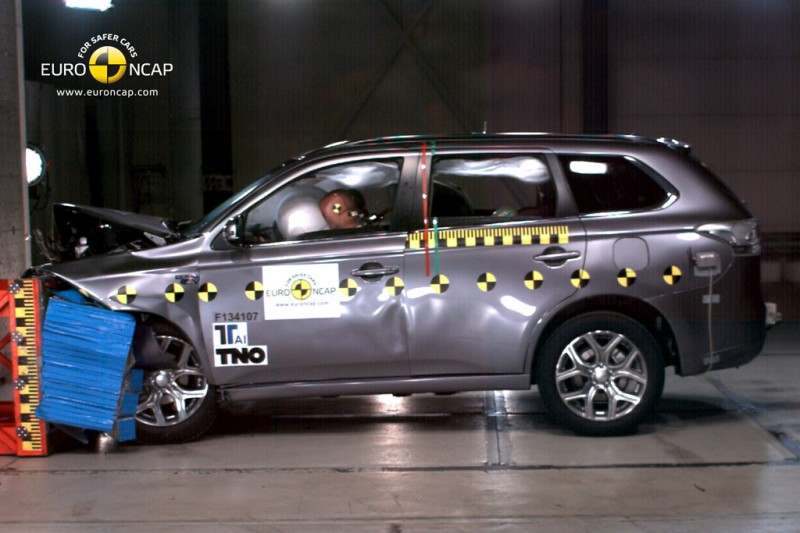Mitsubishi’s Outlander PHEV has been put through it’s paces by the crash test team at Euro NCAP. The non PHEV car was tested last year, but as the new PHEV is significantly heavier due to the onboard electronics for the hybrid system, Euro NCAP saw fit to retest the whole vehicle. Not only that but the pedestrian safety tests had also changed since last year and as such bonnet tests were repeated on the new PHEV version. Scoring the maximum five star rating, Mitsubishi have done rather well!
Adult occupant
The passenger compartment remained stable in the frontal impact. Dummy readings showed good protection of the knees and femurs of both the driver and passenger. Mitsubishi showed that a similar level of protection would be provided to occupants of different sizes and to those sat in different positions. Readings in the driver dummy’s tibia indicated a marginal level of protection of the lower legs. In the side barrier test, the Outlander PHEV scored maximum points, with good protection of all body regions. In the more severe side pole test, dummy readings of chest compression indicated marginal protection of the chest. The front seats and head restraints provided good protection against whiplash injuries in the event of a rear-end collision.
Child occupant
Based on dummy readings in the dynamic tests, the Outlander PHEV svored maximum points for its protection of the 1½ year infant. In the frontal impact, forward movement of the head of the 3 year dummy, sat in a forward-facing restraint, was not excessive and deceleration of the chest indicated fair protection of this body area. In the side impact, both dummies were properly contained by the protective shells of their restraints, minimising the likelihood of head contact with parts of the vehicle interior. The front passenger airbag can be disabled to allow a rearward-facing child restraint to be used in that seating position. Clear information is provided to the driver about the status of the airbag and the system was rewarded. The dangers of using a rearward-facing restraint in that seat without first disabling the airbag are clearly indicated in the car. Mitsubishi will update the user manual for the Outlander PHEV to make clear which categories of child restraints are suitable for which seating positions, and the score reflects this updated information. Earlier cars would have received the same star rating as the changes in the manual have only a small influence on the score.
Pedestrian
The bumper scored maximum points for its protection of pedestrians’ legs. However, the front edge of the bonnet was poor in all areas tested and scored no points. The bonnet surface provided predominantly good or adequate protection to the head of a struck pedestrian with some poor results recorded only on the stiff windscreen pillars.
Safety assist
The Outlander PHEV has electronic stability control as standard, and met Euro NCAP’s test requirements. The front and rear seats are protected by a standard-fit seatbelt reminder system and the car has a driver-set speed limitation device which met test requirements for systems of that type.
Outlander PHEV – Passive Safety Digest
- Reinforced underbody construction coupled with an additional four-member battery frame directly connected with the chassis, strengthen the entire body and improve collision protection.
- New sealed drive battery pack construction to allow the watertight battery pack meets tough SUV driving standards.
- Metal battery pack tray made of rigid sheet metal associated to a solid frame-weld construction to increase the durability of the battery pack while also sufficiently blocking electromagnetic waves.
- Protective battery-pack tray under-coating to help protecting the battery from flying rocks and other road debris.
Source; Euro NCAP

